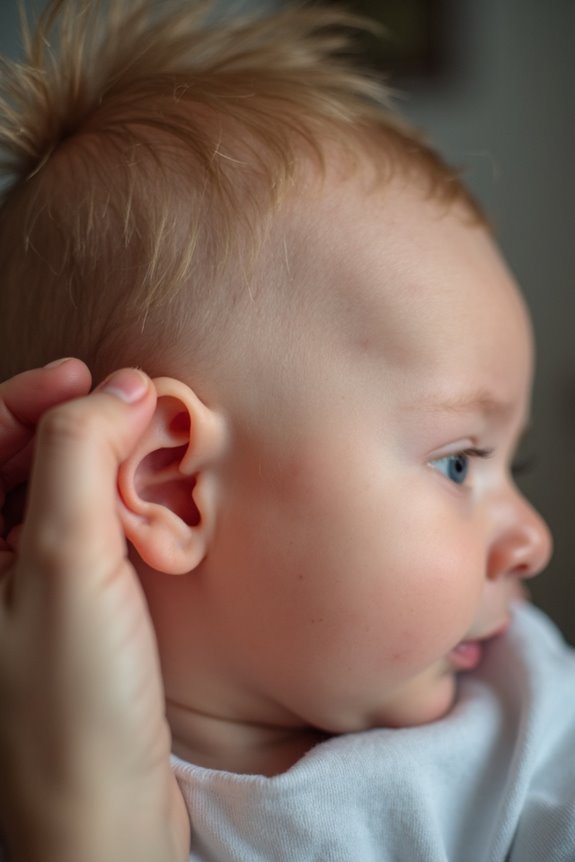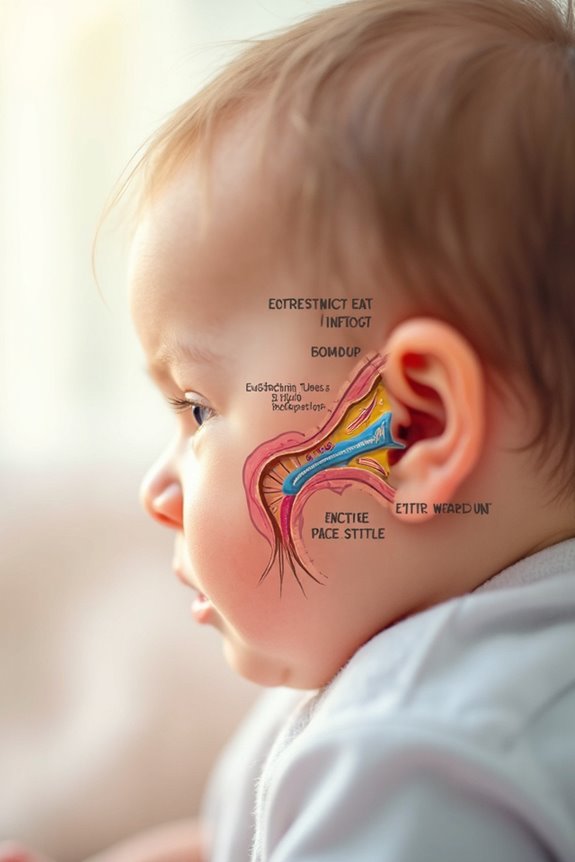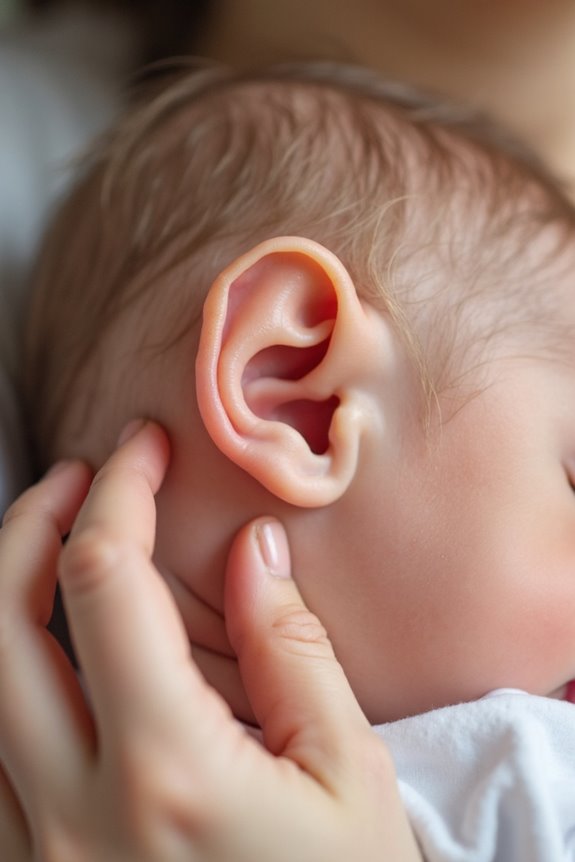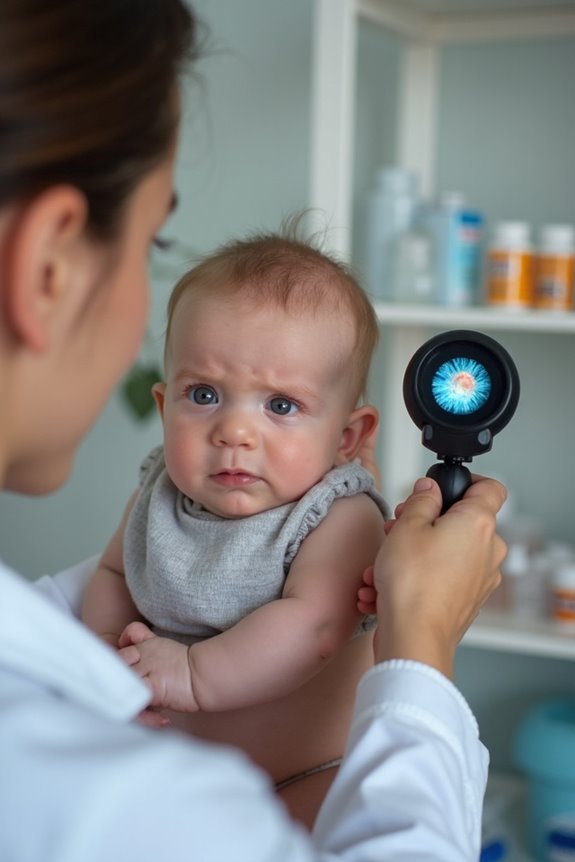Ear infections in babies often happen when viruses or bacteria get into the space behind their eardrums. This can cause pain and fluid buildup. Babies are especially prone because their eustachian tubes are shorter, hindering fluid drainage. To prevent these infections, make sure to: keep up with vaccinations, practice regular handwashing, avoid secondhand smoke, and opt for breastfeeding. Implementing these strategies helps guard against infections. Let’s discover in detail how we can better protect our little ones.
Key Takeaways
- Babies develop ear infections due to shorter, horizontal eustachian tubes that hinder fluid drainage and ventilation.
- Exposure to viral infections like colds and flu can cause pathogens to invade the middle ear.
- Environmental factors, such as secondhand smoke, increase the risk of respiratory issues and infections.
- Immature immune systems in young children make them more susceptible to ear infections.
- Vaccinations and breastfeeding significantly reduce the risk of ear infections in infants.
Understanding Ear Infections in Babies
Why do babies seem to get ear infections so often? It’s a question many of us ponder as we navigate the challenges of parenthood. Ear infections, or acute otitis media, occur when viruses or bacteria invade the space behind the eardrum. This leads to symptoms like ear pain and fluid buildup.
When fluid accumulates, it can cause discomfort and even temporary hearing loss. We might notice our little ones tugging at their ears or becoming unusually irritable. In these moments, it’s crucial to recognize signs like fluid discharge or changes in hearing.
Managing these symptoms involves:
- Using pain relievers such as ibuprofen.
- Observing for fever or loss of balance.
- Seeking prompt medical attention when necessary.
Common Causes of Ear Infections

When we delve into the common causes of ear infections in babies, it becomes clear that a variety of factors are at play. Often, viral infections like colds and flu set the stage by spreading pathogens to the middle ear. Bacterial infections, such as those caused by *Streptococcus pneumoniae*, can follow, leading to more severe cases.
We should also pay attention to lifestyle and environmental factors. For example, exposure to secondhand smoke or poor air quality can exacerbate respiratory issues, increasing the risk of infections. Moreover, anatomical factors like the small, horizontal eustachian tubes in young children make fluid drainage difficult, allowing bacteria and viruses to thrive. These elements, combined with nasal congestion, make ear infections a common concern for our little ones.
The Role of Eustachian Tubes

Understanding how babies develop ear infections involves looking closely at the role of eustachian tubes. In children, eustachian tube anatomy is crucial since these tubes are shorter, more horizontal, and have a less flexible cartilaginous structure. This affects their drainage and ventilation capabilities. Let’s explore the eustachian tube function:
- Air Pressure Regulation: These tubes help balance the air pressure on both sides of the eardrum, essential for hearing.
- Fluid Drainage: Eustachian tubes assist in draining fluid from the middle ear to the nasopharynx, reducing infection risk.
- Ventilation: Proper ventilation is key to preventing fluid buildup, a common precursor to infections.
Risk Factors for Ear Infections

While many factors contribute to the development of ear infections in babies, understanding the risk factors can help us better protect our little ones. Let’s dive into what we can do to reduce these risks.
Age Factors
- Peak incidence is between six and 15 months.
- Young children’s immature immune systems make them more prone to infections.
Environmental Influences
- Exposure to tobacco smoke, crowded living conditions, and pollution increases risk.
- Group child care settings can expose babies to more pathogens.
Genetic Predisposition
- Family history and white ethnicity can heighten susceptibility.
- Boys might be marginally more affected.
Lifestyle Choices
- Breastfeeding reduces risk, while lack of it can increase susceptibility.
- Ensuring vaccinations and regular check-ups can prevent infections.
Anatomy and Susceptibility

Now that we’ve explored the risk factors, let’s look at how a baby’s ear anatomy plays a role in their susceptibility to infections.
- Outer Ear: Babies have a narrower external auditory canal, making it easier for bacteria to become trapped. The canal’s skin is lined with ceruminous glands that produce wax, which can lead to cerumen impaction and increased infection risk.
- Middle Ear: The middle ear, home to the ossicles, is vulnerable due to its connection to the eustachian tube. This tube, narrower and more horizontal in infants, can easily become blocked, leading to fluid buildup and infection.
Understanding these anatomical factors helps us appreciate why infants are more susceptible to ear infections, highlighting the need for vigilant care and attention.
Effective Prevention Strategies

To effectively prevent ear infections in babies, let’s explore a range of strategies that you can incorporate into daily life. Vaccines play a vital role in prevention—ensuring your child receives the pneumococcal and flu vaccines increases vaccine effectiveness, safeguarding against bacteria and viruses that cause infections. Prioritize hygiene practices by washing hands regularly, especially after bathroom visits and before meals, to keep germs at bay.
Consider these additional tips:
- Avoid Sick Individuals: Limit your baby’s exposure to those who are ill.
- Secondhand Smoke: Steer clear of it, as it heightens infection risk.
- Breastfeeding: If possible, breastfeed exclusively for six months, continuing up to a year.
- Feeding Techniques: Feed in an upright position to prevent fluid buildup.
Adopting these strategies can significantly reduce ear infection risks.
Treatment and Management Options

When it comes to treating and managing ear infections in babies, there are several effective options that we can explore together. Let’s start with pain relief: over-the-counter medications like ibuprofen or acetaminophen can ease discomfort. A warm compress applied gently to the ear might offer additional soothing.
For more persistent cases, antibiotics such as amoxicillin are often necessary, prescribed for a typical duration of 7 to 10 days. If infections become chronic, surgical interventions might be considered. Procedures like a myringotomy can drain fluid, while tympanostomy tubes facilitate airflow and prevent future fluid buildup.
Frequently Asked Questions
How Long Does It Take for an Ear Infection to Heal in Babies?
Time heals like a gentle whisper. For babies, the healing timeline varies. Ear infection duration often spans a week or two, yet fluid can linger up to six weeks. Let’s ensure their comfort with love and care.
Can Ear Infections Affect a Baby’s Speech Development?
We understand your concerns. Yes, ear infections can lead to speech delays in babies due to hearing loss. It’s crucial we monitor and address infections early to support our little one’s speech and auditory development.
Are There Any Natural Remedies for Treating Ear Infections in Babies?
Let’s explore gentle herbal treatments for our little ones. Ginger, garlic oil, and soothing techniques like warm compresses provide comfort. Keeping them hydrated and using massages can help ease the journey through these ear troubles together.
Is It Safe for a Baby With an Ear Infection to Fly?
We should be cautious when flying with a baby who has an ear infection. Ear pressure changes can worsen their discomfort. Consulting a doctor for flying precautions, like pain management and breastfeeding during takeoff, is essential.
What Symptoms Indicate the Need for Immediate Medical Attention?
When ear infection symptoms like high fever, severe pain, or unusual discharge arise, let’s not wait. Immediate urgent care is crucial. Our little one’s health and comfort are paramount, and timely attention can prevent complications.





